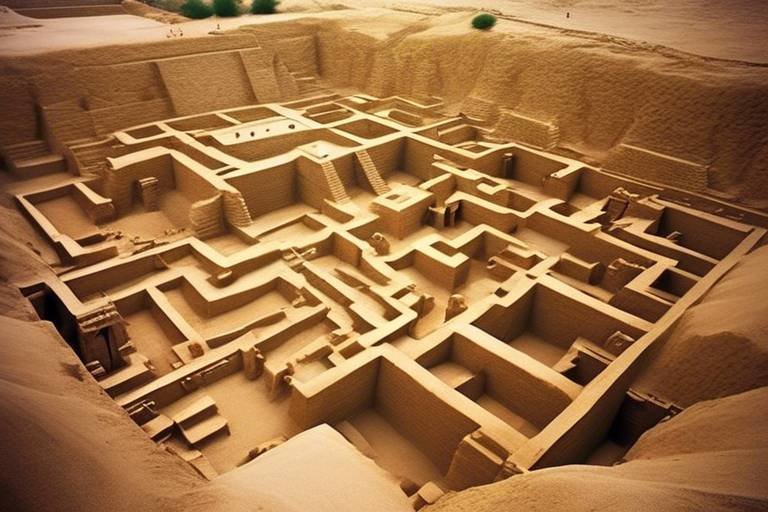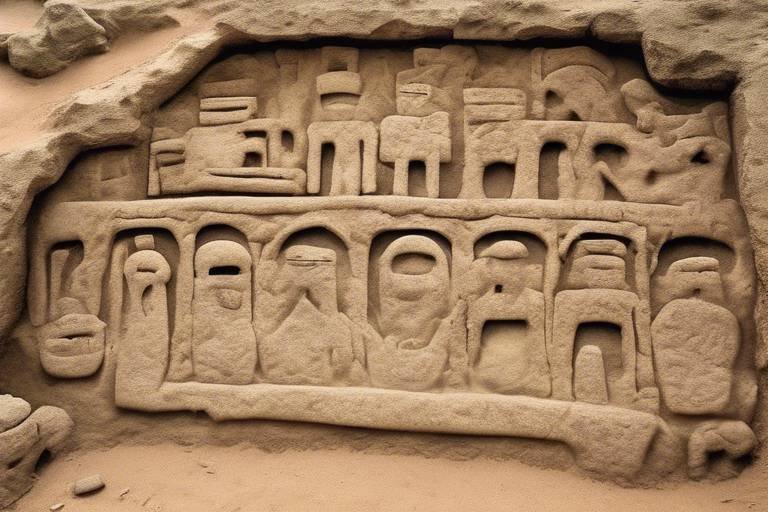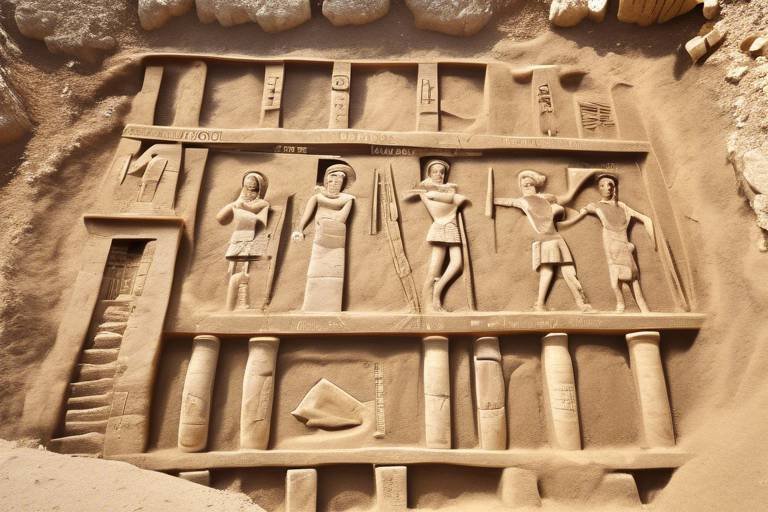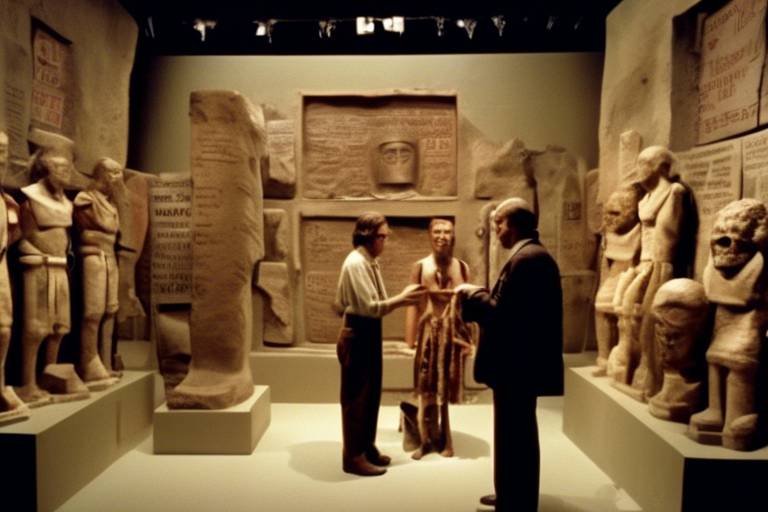How Radiocarbon Dating Revolutionized Archaeology
Radiocarbon dating has completely transformed the field of archaeology, offering researchers a powerful tool to accurately date artifacts and unravel the mysteries of ancient civilizations. This groundbreaking method has revolutionized how we understand the past, providing invaluable insights into the timeline of human history.

Discovery of Radiocarbon Dating
This article explores the impact of radiocarbon dating on the field of archaeology, revolutionizing the way researchers date artifacts and understand ancient civilizations.
Radiocarbon dating, also known as carbon dating, was discovered in the 1940s by scientist Willard Libby. This groundbreaking method uses the decay of carbon-14 isotopes in organic materials to determine their age accurately.
The fundamental principle behind radiocarbon dating lies in the fact that carbon-14 isotopes decay at a known rate over time. By measuring the remaining carbon-14 in a sample, archaeologists can calculate its age with remarkable precision.
Radiocarbon dating is widely used in archaeology to date organic materials such as bones, wood, and charcoal. This method has been instrumental in determining the age of ancient artifacts, human remains, and archaeological sites.
Despite its accuracy, radiocarbon dating has limitations, especially when dating materials older than 50,000 years due to the decay of carbon-14 isotopes. Contamination and calibration issues can also pose challenges in obtaining precise dates.
Technological advancements, such as Accelerator Mass Spectrometry (AMS), have significantly improved the accuracy and efficiency of radiocarbon dating. These innovations have allowed researchers to analyze smaller samples and obtain more precise dates.
Radiocarbon dating is often combined with other dating methods, such as dendrochronology and stratigraphy, to create a more comprehensive timeline of archaeological events. By integrating multiple techniques, researchers can cross-validate dates and enhance the accuracy of their findings.
The future of radiocarbon dating in archaeology holds exciting possibilities, with ongoing research focusing on refining dating techniques and expanding the range of materials that can be dated. These advancements will continue to deepen our understanding of past civilizations.
Ethical considerations in radiocarbon dating involve respecting cultural heritage, obtaining proper permissions for sample collection, and responsibly interpreting and disseminating results. Archaeologists must navigate these ethical dilemmas to ensure the integrity of their research.

Principles of Radiocarbon Dating
This article explores the impact of radiocarbon dating on the field of archaeology, revolutionizing the way researchers date artifacts and understand ancient civilizations.
Radiocarbon dating is based on the principle of radioactive decay of Carbon-14 isotopes in organic materials. When an organism dies, it stops absorbing Carbon-14, allowing scientists to measure the remaining levels to determine its age.
This method relies on the fact that Carbon-14 decays at a consistent rate over time, providing a reliable timeline for dating archaeological samples.
By comparing the ratio of Carbon-14 to Carbon-12 in a sample to the known ratio in the atmosphere, researchers can calculate the age of the sample with remarkable precision.
The half-life of Carbon-14, approximately 5,730 years, allows scientists to date samples up to around 50,000 years old, making radiocarbon dating a powerful tool in archaeological research.

Applications in Archaeology
When it comes to the field of archaeology, radiocarbon dating has truly been a game-changer, offering researchers a powerful tool to unravel the mysteries of the past. One of the key applications of radiocarbon dating in archaeology is its ability to accurately determine the age of organic materials, such as bone, charcoal, and plant remains, that are thousands of years old.
By analyzing the amount of radioactive carbon-14 remaining in these materials, archaeologists can establish a timeline for ancient civilizations, dating back to as far as 50,000 years. This precision in dating artifacts allows researchers to construct detailed chronologies of human history, tracing the development of societies and understanding cultural changes over time.
Moreover, radiocarbon dating plays a crucial role in determining the authenticity of archaeological finds, helping to identify forgeries and prevent the circulation of fake artifacts in the market. This application is particularly significant in the preservation of cultural heritage and ensuring the integrity of historical collections around the world.
Furthermore, radiocarbon dating is instrumental in studying environmental changes throughout history, as it enables researchers to track fluctuations in climate and reconstruct past landscapes. By dating organic materials found in sediment cores or archaeological sites, scientists can piece together a timeline of environmental events and understand how human activities have impacted ecosystems over millennia.
In addition to dating artifacts and environmental samples, radiocarbon dating is also used in forensic archaeology to investigate crime scenes and identify human remains. By analyzing the carbon-14 levels in bones or tissues, forensic experts can determine the age of the deceased individual and provide valuable information for criminal investigations.
Overall, the applications of radiocarbon dating in archaeology are vast and diverse, offering invaluable insights into the past and shaping our understanding of ancient civilizations. From dating artifacts to studying environmental changes and aiding forensic investigations, this revolutionary dating method continues to push the boundaries of archaeological research.

Challenges and Limitations
When it comes to radiocarbon dating in archaeology, there are certain challenges and limitations that researchers encounter in their quest to unravel the mysteries of the past. One of the main challenges is the issue of contamination, where modern carbon can mix with ancient samples, leading to inaccurate results. This contamination can come from various sources such as handling, storage, or environmental factors.
Another limitation of radiocarbon dating is the difficulty in dating certain materials. Some artifacts may not contain enough carbon for accurate dating, or they could be too old for radiocarbon dating to provide reliable results. Additionally, the calibration curve used in radiocarbon dating is constantly being refined, which can introduce uncertainties in the dating process.
Furthermore, the process of radiocarbon dating can be time-consuming and expensive, requiring specialized equipment and expertise. This can limit the number of samples that can be dated, slowing down research progress in some cases. Additionally, the availability of suitable samples for dating can also pose a challenge, especially in cases where preservation conditions have not been optimal.
In order to address these challenges and limitations, researchers are constantly striving to improve the techniques and methodologies used in radiocarbon dating. Advancements in technology and analytical methods have helped to overcome some of these obstacles, enhancing the accuracy and reliability of radiocarbon dating in archaeological studies.

Advancements in Radiocarbon Dating Technology
Advancements in radiocarbon dating technology have significantly enhanced the accuracy and precision of dating ancient artifacts and archaeological samples. One of the key innovations is Accelerator Mass Spectrometry (AMS), which allows for smaller sample sizes and faster results compared to traditional radiometric dating methods. This breakthrough has revolutionized the field by enabling researchers to analyze samples that were previously considered too small or precious to date accurately.
Furthermore, the development of calibration curves based on tree-ring data has improved the accuracy of radiocarbon dating by accounting for fluctuations in atmospheric carbon levels over time. These curves provide a more precise timeline for dating artifacts and can correct discrepancies in radiocarbon dates caused by variations in carbon isotopes.
Another significant advancement is the use of Bayesian statistical models to analyze radiocarbon data in conjunction with other archaeological information. By integrating radiocarbon dates with stratigraphic data, historical records, and artifact typologies, researchers can create more robust chronological frameworks for archaeological sites and cultural sequences.

Integration with Other Dating Methods
When it comes to understanding the past, archaeologists often rely on a combination of dating methods to piece together a comprehensive timeline of events. Radiocarbon dating plays a crucial role in this process by providing key insights into the age of organic materials. However, it is rarely used in isolation. Instead, it is integrated with other dating methods to cross-validate findings and create a more accurate picture of history.
One common approach is to combine radiocarbon dating with dendrochronology, also known as tree-ring dating. Dendrochronology involves analyzing the growth rings of trees to determine their age, providing a precise timeline that can be correlated with radiocarbon dates. By overlapping these two methods, researchers can refine their dating estimates and identify any discrepancies that may arise.
Another method that complements radiocarbon dating is optically stimulated luminescence (OSL) dating. OSL dating measures the last time quartz grains were exposed to sunlight, helping archaeologists date sediments and geological materials that are beyond the reach of radiocarbon dating. By integrating OSL dating with radiocarbon dating, researchers can extend the chronological range of their studies and obtain a more comprehensive understanding of past events.
Furthermore, thermoluminescence dating is another technique that can be used in conjunction with radiocarbon dating. Thermoluminescence dating is particularly useful for dating ceramics and burnt stones, as it determines the time elapsed since these materials were last heated or exposed to sunlight. By combining thermoluminescence dating with radiocarbon dating, archaeologists can obtain more accurate dates for artifacts and archaeological sites.

Future of Radiocarbon Dating in Archaeology
Radiocarbon dating has already transformed the field of archaeology, but what does the future hold for this groundbreaking technology? As advancements continue to push the boundaries of scientific dating methods, the future of radiocarbon dating in archaeology looks promising and full of potential.
One exciting aspect of the future of radiocarbon dating is the ongoing development of more precise and accurate techniques. Scientists are constantly refining the methods used to date artifacts, allowing for greater accuracy in determining the age of ancient objects. This increased precision opens up new possibilities for researchers, enabling them to unravel mysteries of the past with even greater detail.
Furthermore, the integration of radiocarbon dating with other scientific dating methods is set to play a crucial role in the future of archaeological research. By combining radiocarbon dating with techniques such as dendrochronology and thermoluminescence dating, researchers can create more comprehensive timelines of human history. This multidisciplinary approach promises to provide a more nuanced understanding of ancient civilizations and their development over time.
As technology continues to advance, the future of radiocarbon dating may also see the emergence of new innovative applications. From exploring previously inaccessible archaeological sites to dating organic materials with unprecedented accuracy, the possibilities are endless. These advancements have the potential to revolutionize the way we study the past and gain insights into the lives of our ancestors.
However, with these exciting advancements come ethical considerations that must be carefully addressed. As radiocarbon dating technology evolves, researchers must navigate issues such as the proper handling of sensitive cultural heritage and the ethical implications of dating human remains. Balancing scientific progress with respect for the past is essential to ensure that radiocarbon dating continues to be a valuable tool in archaeological research.

Ethical Considerations in Radiocarbon Dating
When it comes to the ethical considerations surrounding radiocarbon dating in archaeology, there are several key points that researchers must take into account. One of the primary concerns is the potential destruction of valuable artifacts during the dating process. While radiocarbon dating provides invaluable information about the age of an object, the process often requires a small sample to be taken from the artifact, which can be a point of contention for some individuals and communities.
Additionally, there is the issue of cultural sensitivity and respect for indigenous communities. It is crucial for archaeologists and researchers to work closely with local communities and indigenous groups when conducting radiocarbon dating studies to ensure that their cultural heritage is being treated with the utmost care and respect. This includes obtaining proper consent and involving community members in the research process.
Another ethical consideration is the interpretation and dissemination of radiocarbon dating results. It is essential for researchers to present their findings accurately and responsibly, avoiding sensationalism or misrepresentation of data. Clear communication of the limitations and uncertainties associated with radiocarbon dating is crucial to maintaining the integrity of archaeological research.
Furthermore, there is a growing concern about the commercialization of radiocarbon dating services and the potential exploitation of archaeological sites for profit. Researchers must navigate the ethical implications of funding sources and commercial interests to ensure that their work remains objective and focused on advancing scientific knowledge rather than financial gain.
In conclusion, while radiocarbon dating has revolutionized the field of archaeology and provided invaluable insights into the past, it is essential for researchers to approach this method with careful consideration of the ethical implications involved. By prioritizing transparency, respect for cultural heritage, and responsible interpretation of data, archaeologists can continue to harness the power of radiocarbon dating in a way that benefits both the scientific community and society as a whole.
Frequently Asked Questions
- What is radiocarbon dating?
Radiocarbon dating is a method used by archaeologists to determine the age of organic materials based on the decay rate of carbon isotopes.
- How accurate is radiocarbon dating?
Radiocarbon dating can provide fairly accurate dates for materials up to around 50,000 years old. However, accuracy can be affected by various factors such as contamination and calibration issues.
- Why is radiocarbon dating important in archaeology?
Radiocarbon dating is crucial in archaeology as it helps researchers establish chronologies, date artifacts, and understand the timeline of ancient civilizations, providing valuable insights into human history.
- What are the limitations of radiocarbon dating?
Some limitations of radiocarbon dating include its inability to date materials older than around 50,000 years, the potential for contamination, and the need for calibration to account for fluctuations in carbon isotopes.
- How does radiocarbon dating work?
Radiocarbon dating works by measuring the amount of carbon-14 isotopes in a sample and comparing it to the stable carbon isotopes. By calculating the ratio of carbon-14 to carbon-12, the age of the sample can be determined.
- Can radiocarbon dating be used on all artifacts?
Radiocarbon dating is primarily used on organic materials such as bone, charcoal, wood, and plant remains. It is not suitable for dating materials like rocks or metals.



















